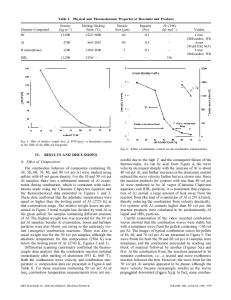In situ combustion synthesis of dense ceramic and ceramic-metal interpenetrating phase composites
- PDF / 1,418,645 Bytes
- 9 Pages / 603.28 x 783.28 pts Page_size
- 49 Downloads / 359 Views
I.
INTRODUCTION
THE application of a novel one-step in situ combustion synthesis technique for the production of ceramicmetal interpenetrating phase composites (IPC) is described in this article. Combustion (self-propagating high-temperature) synthesis (SHS) uses an exothermic reaction to provide the energy needed to synthesize ceramics, intermetallics, and composites, t~.2] The exotheiTnic reactant mixture, normally in the form of powders, is pressed into a pellet of a certain green density and is subsequently ignited, either locally at one point (propagating mode) or by heating the whole pellet to the ignition temperature of the exothermic reaction (simultaneous combustion mode). A schematic representation of a typical temperature-time plot for a combustion reaction is given in Figure l(a). The reactant mixture, at initial temperature, To, is heated to the ignition temperature, Tig, whereupon the reaction is initiated. Sufficient heat is released by the exothermic reaction, as indicated in Figure 1(a), in order to achieve a maximum or combustion temperature, T,., and to sustain the reaction without the need for additional heat. The exothermicity of the combustion synthesis reaction plays an important part in the stability of the reaction and the combustion temperature achieved, which consequently control both the microstructure and properties of the synthesized products. The thermochemistry of these SHS reactions can best be explained by examining the enthalpy of the reactants and products as a function of temperature, ]31 as indicated in Figure 2. Consider an exothermic combustion synthesis reaction in which a green reactant powder mix, at an initial temperature, To, is ignited under adiabatic conditions in the propagating mode at an ignition temperature, Tie. In order for the reaction to ignite at T~g, the reactants need to be heated from To to Tie. Therefore, the amount of heat, H(R), needed to do this is given by the following: tI(R) =
~ njCp(Ri)dr + ~'. njL(Ri)
[11
T o - Ti~
H.J. FENG, Postdoctoral Fellow, and J.J. MOORE, Professor and Department Head, are with the Department of Metallurgical and Materials Engineering, Colorado School of Mines, Golden, CO 80401. Manuscript submitted June 28, 1994.
METALLURGICAL AND MATERIALS TRANSACTIONS B
where ni, Cp(Ri), and L(Ri) are the reaction stoichiometry coefficients, heat capacities, and the phase transformation enthalpies (if the reactant(s) undergo a phase change, e.g., melting), respectively, of the reactants, Ri. The value of H(R) is indicated in Figure 2. Since the combustion synthesis reaction is initiated at Tiu, the heat of the reaction under these conditions is given by M-/(Tig), also indicated on the H-T plot in Figure 2. Since H(R) is needed to heat the reactants from To to Tig, the amount of heat available to be absorbed by the products under adiabatic conditions is, therefore, H(P), such that H(P) raises the temperature of the products from Ti~ to Tad (To). Thus, the total heat generated by the SHS reaction, zkl-l(Tig), is distributed between
Data Loading...











